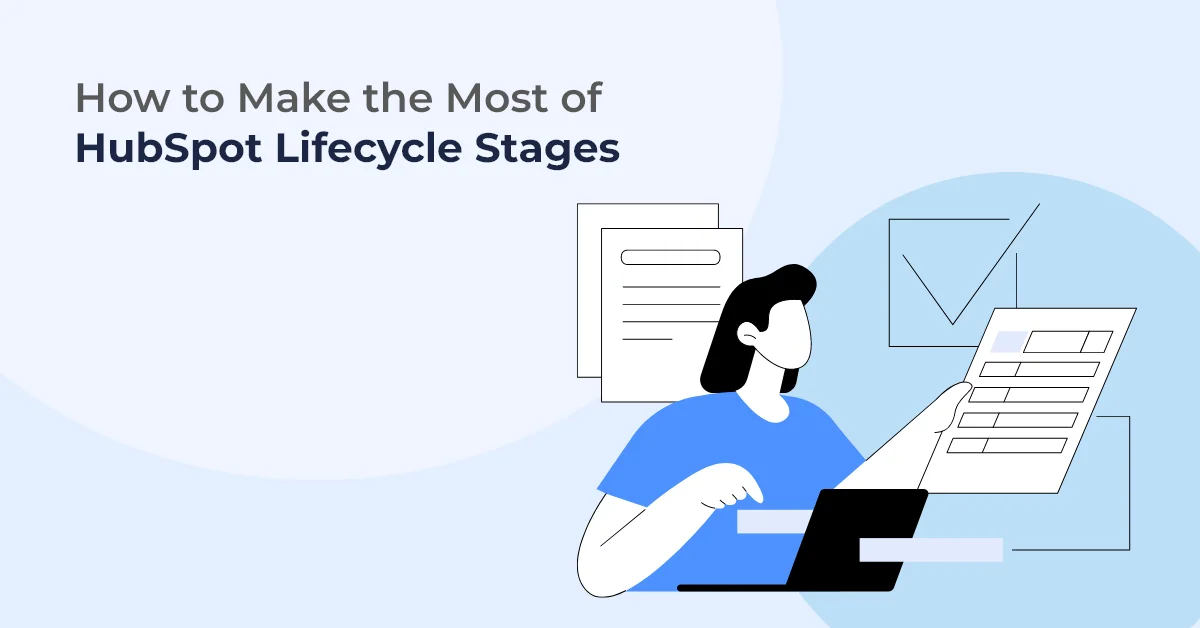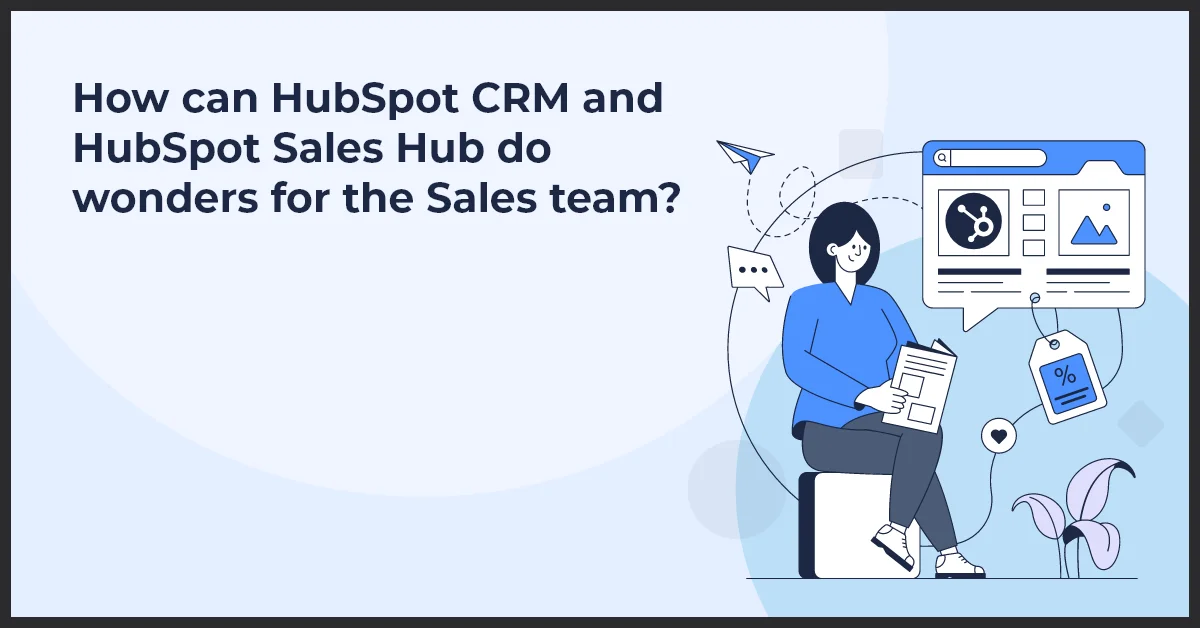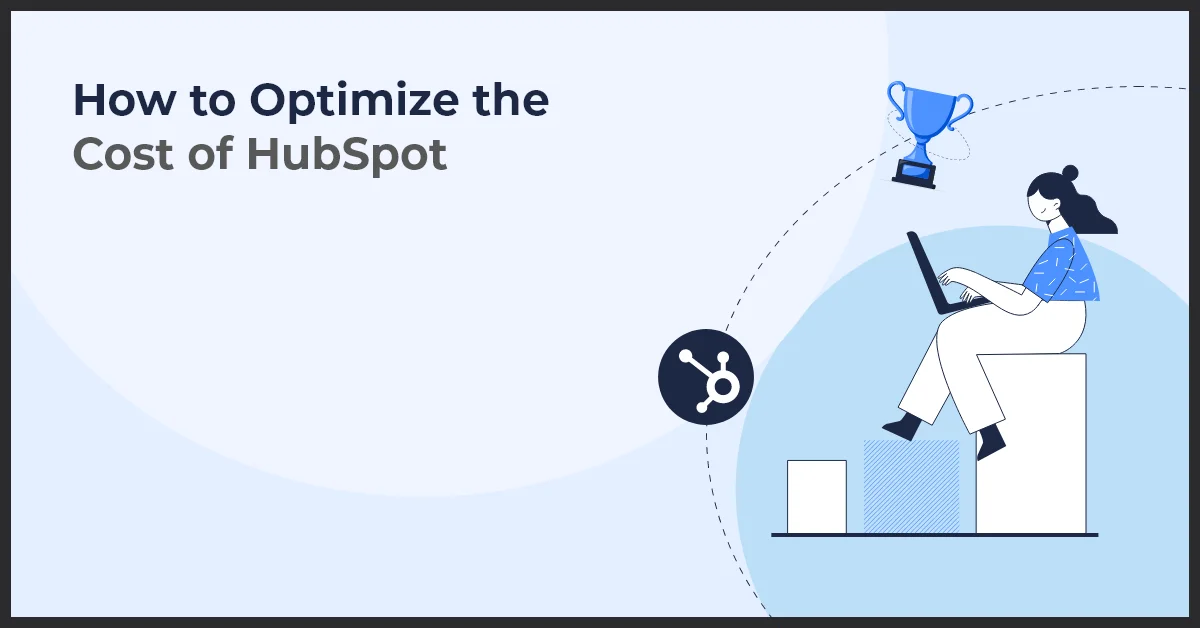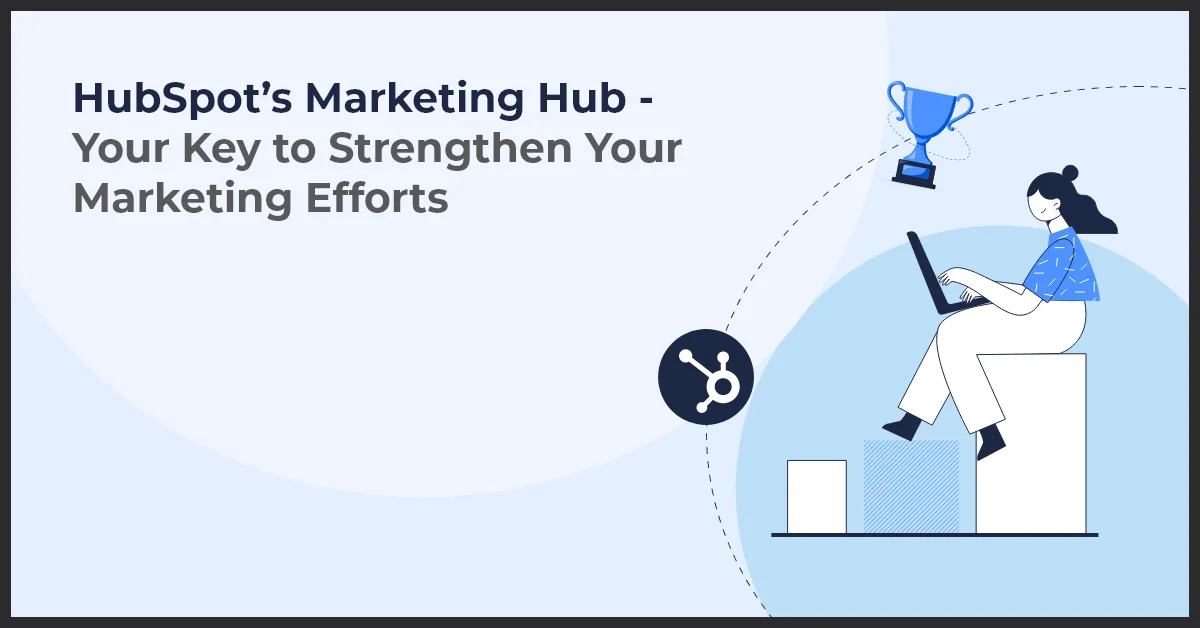Maximizing HubSpot Lifecycle Stages for Business Growth

Published on: June 30, 2022
Updated on: March 28, 2025
2334 Views
- HubSpot
14 min read
HubSpot’s lifecycle stages are a set of detailed stages that a potential customer moves through as they move along your marketing and sales process. Even though the lifecycle stages are building blocks of HubSpot, they are among the most underused, underappreciated, and underestimated tools in the HubSpot arsenal.
Utilizing every bit of HubSpot’s lifecycle stages is important to strengthen and scale your business’ marketing and sales efforts. Is your business taking complete advantage of these lifecycle stages? If not, we are here to quickly walk you through the basics and how you can get the most out of it for growing your business exponentially.
Lifecycle stages are labels to where a prospect is in your sales and marketing pipeline. With an efficient understanding of the lifecycle stages in HubSpot, you can easily:
- Organize and segment your contacts
- Nurture leads
- Convert more prospects into long-term customers
An effective and reliable framework helps you communicate with your prospects—how to meet them where they are.
Even the most experienced HubSpotters can feel overwhelmed at times with the extensive list of features and tools. So we are here to help you better understand the lifecycle stages as one of the most powerful tools of HubSpot.
What is HubSpot?
HubSpot is a leading customer relationship management (CRM) platform designed to help businesses attract, engage, and delight customers. It offers a suite of tools and features to assist with marketing, sales, and customer service, all aimed at driving growth and success.
Importance of understanding HubSpot Lifecycle Stages for businesses
Understanding the HubSpot Lifecycle Stages is crucial for businesses as it provides a structured framework to identify and classify leads or customers at different stages of their buying journey. By analyzing these stages, businesses can gain insights into their target audience, track their interactions and behavior, and tailor specific strategies to nurture them effectively.
Benefits of implementing HubSpot Lifecycle Stages to optimize sales and marketing processes
By implementing HubSpot Lifecycle Stages, businesses can streamline their sales and marketing processes. They can efficiently segment their audience, target specific messages and offers to resonate with their needs, and improve overall lead generation and conversion rates. With a better understanding of where leads are in the buyer's journey, businesses can personalize their communication, shorten the sales cycle, and maximize revenue.
Understanding HubSpot Lifecycle Stages
In order to effectively leverage the power of HubSpot and maximize your business success, it is crucial to understand the concept of HubSpot Lifecycle Stages. These stages play a pivotal role in guiding your marketing and sales efforts, ensuring that you engage with your audience at the right time and in the right way.
A. Definition of HubSpot Lifecycle Stages
HubSpot Lifecycle Stages are a framework used to categorize and organize contacts based on their level of engagement with your brand. These stages help you identify where each contact stands in their buying journey and enable you to tailor your messaging and strategies accordingly.
The four main HubSpot Lifecycle Stages are:
- Subscriber: This stage represents individuals who have shown interest in your brand by subscribing to your newsletter or following your social media channels. They are at the initial stage of their customer journey.
- Lead: Leads are contacts who have provided their information, such as filling out a form on your website or requesting a demo. They have shown a higher level of interest and engagement in your offerings.
- MQL (Marketing Qualified Lead): MQLs are leads that have been deemed qualified by your marketing team based on certain criteria. They have shown genuine interest and have the potential to become customers.
- SQL (Sales Qualified Lead): SQLs are leads that have been qualified by your sales team as having a high likelihood of converting into paying customers. They have shown strong intent to purchase and are ready for a sales engagement.
B. Overview of the different stages in the HubSpot Lifecycle
Each of these stages represents a crucial milestone in the customer journey. By understanding the characteristics of each stage, you can tailor your marketing and sales strategies to effectively nurture contacts and guide them through the sales funnel.
Subscriber Stage: At this stage, your focus should be on delivering valuable content that educates and engages the subscribers. By providing relevant information, you can build trust and establish your brand as an authority in their eyes.
Lead Stage: Leads have shown a higher level of interest, and it's important to nurture them further to keep them engaged. Personalized emails, targeted content, and product demos can be effective in nurturing leads and moving them closer to becoming qualified leads.
MQL Stage: At this stage, marketing and sales alignment is crucial. Ensuring that MQLs receive personalized and timely communication from both teams can help in converting them into sales qualified leads. Lead scoring and behavior tracking can aid in identifying the most qualified leads for your sales team to focus on.
SQL Stage: Sales qualified leads are ready for direct sales engagement. Your sales team should focus on providing tailored solutions, addressing any concerns or objections, and guiding these leads towards making a purchasing decision.
By understanding the nuances of each stage and implementing appropriate strategies, you can efficiently move contacts through the lifecycle stages, accelerating your sales process and driving business success.
HubSpot Lifecycle Stages and their Significance in the Customer Journey
In the customer journey, understanding the various stages that customers go through is crucial for effective marketing and sales strategies. HubSpot Lifecycle Stages provide a comprehensive framework that helps businesses categorize their leads, prospects, and customers based on their specific stage in the customer journey.
By utilizing HubSpot Lifecycle Stages, businesses can tailor their communication and marketing efforts to better meet the needs and requirements of each stage, ultimately improving customer satisfaction and driving business growth.
A. Marketing Funnel Stages
1. Top-of-the-Funnel (TOFU) stage: This is the awareness stage where potential customers become aware of their problem or need. It is important for businesses to create content and campaigns that attract and engage these potential customers.
2. Middle-of-the-Funnel (MOFU) stage: In this consideration stage, potential customers are evaluating their options and comparing different solutions. Businesses should provide valuable information and resources to help these leads make informed decisions.
3. Bottom-of-the-Funnel (BOFU) stage: At this decision stage, potential customers are ready to make a purchase. Businesses should focus on providing personalized offers, incentives, and a seamless buying experience to convert these leads into customers.
B. Sales Funnel Stages
1. Prospecting stage: This is the initial stage of the sales process where potential leads are identified and qualified. Sales teams utilize various prospecting techniques to find and connect with potential customers.
2. Qualification stage: In this stage, sales teams evaluate the potential leads to determine their fit and readiness for the product or service. Qualified leads are prioritized for further engagement.
3. Proposal stage: Once qualified, sales teams create and present customized proposals or quotes to potential customers. This stage involves negotiations and addressing any objections or concerns.
4. Closing stage: This final stage focuses on sealing the deal and converting the prospect into a paying customer. Sales teams work towards overcoming any remaining hurdles and facilitating the purchase process.
C. Customer Lifecycle Management
1. Onboarding stage: After the purchase, customers enter the onboarding stage where they are introduced to the product or service. The goal is to help customers get started smoothly and understand how to derive the most value from the offering.
2. Adoption stage: In this stage, customers start actively using the product or service. It is important for businesses to provide ongoing support, training, and resources to ensure customer satisfaction and encourage continued usage.
3. Retention stage: Successful businesses aim to retain their customers over time. This stage involves continuous nurturing, delivering exceptional customer experiences, and proactively addressing any concerns or issues that may arise.
4. Advocacy stage: At this stage, satisfied customers become advocates and promote the brand to others through referrals, testimonials, and positive reviews. Their advocacy can significantly impact new customer acquisition and overall brand reputation.
By recognizing and understanding the significance of these various HubSpot Lifecycle Stages in the customer journey, businesses can effectively map out their marketing and sales strategies, deliver targeted messaging, and optimize their processes for improved business success.
Leveraging HubSpot Lifecycle Stages for Business Success
In order to achieve business success, it is crucial to maximize the potential of HubSpot Lifecycle Stages. By effectively leveraging these stages, businesses can optimize their lead generation, nurture leads, streamline the customer acquisition process, improve conversion rates, enhance customer relationship management, implement customer retention strategies, and ensure alignment between sales and marketing teams.
A. Lead Generation Strategies
1. Implementing effective lead capture forms
2. Utilizing targeted content offers
3. Leveraging social media and PPC advertising for lead generation
B. Lead Nurturing Tactics
1. Developing personalized automated email workflows
2. Creating relevant content for each lifecycle stage
3. Implementing lead scoring and segmentation
C. Customer Acquisition Process
1. Defining buyer personas and understanding their needs
2. Implementing lead qualification processes
3. Leveraging HubSpot's automation features to streamline the acquisition process
D. Conversion Rate Optimization
1. Analyzing and optimizing landing pages
2. A/B testing to improve conversion rates
3. Utilizing persuasive copywriting techniques
E. Customer Relationship Management (CRM)
1. Integrating HubSpot CRM for efficient sales and marketing alignment
2. Tracking and managing customer interactions
3. Implementing sales automation features for improved CRM processes
F. Customer Retention Strategies
1. Developing personalized customer success plans
2. Leveraging customer feedback and addressing pain points
3. Offering loyalty programs and incentives for customer retention
G. Sales and Marketing Alignment
1. Aligning on common goals and metrics
2. Regular collaboration and communication between sales and marketing teams
3. Utilizing HubSpot's reporting features to gain insights into the sales and marketing alignment
What Are HubSpot Lifecycle Stages and Why You Should Use Them?
The lifecycle stages within HubSpot are properties that the contacts in your database are automatically tagged to, depending on the way they were acquired. These act as markers between your contact’s relationship with your business and their journey through your entire sales funnel.
HubSpot has 7 lifecycle stages that indicate the types of behaviors that a contact demonstrates at each stage:
- Subscribers are people who are aware of your company and have signed up for your content offers, newsletters, and other services.
- Leads are contacts who have shown meaningful sales interest beyond signing up for content material.
- MQLs are contacts who have interacted with your marketing campaign in a specific, measurable way(s).
- SQLs are contacts who have indicated that they are willing to be contacted by your sales team. SQLs are in the funnel's consideration stage.
- Opportunities are contacts that have been assessed and determined to be actual potential leads based on your lead rating criteria.
- Customers are people who have done business with you and have closed a contract.
- Evangelists are customers who are also raving lovers of your brand.
As many as 96% of visitors who come to your website are not ready to buy. Instead of focusing on closing them too soon, you can leverage lifecycle stages to pinpoint accurately where they are in your funnel and target them with relevant content.
Your contacts' needs will vary depending on where they are in the lifecycle. You need to provide them with relevant offers to convert these leads into paying clients. Your potential customer will be turned off if you share bottom-of-the-funnel content too soon. On the other hand, mentioning your paying clients in an email designed to close the sale might be just as irritating.
When your company's marketing is built on HubSpot's inbound methodology, lifecycle stages are quite essential. A one-size-fits-all approach is not ideal with this technique, which helps you close consumers utilizing appropriate and non-promotional information.
Lifecycle Stages Vs Lead Status: What’s the Difference?
While lifecycle stages and lead statuses may look alike, they are vividly different. Lifecycle stages are the overall sum of steps a contact makes, from the first time they visit your website, until they get converted into customers.
But when a contact is in the sales qualified lead (SQL) lifecycle stage, lead status is closely related to particular actions your sales team is performing. HubSpot offers preset settings, but depending on your sales process, you may want to tweak them more.
Lifecycle phases follow a contact's progress starting from the time they enter into your CRM, whereas lead status follows an SQL's journey from the time they are acquired until closed. Lead status is thus, in a sense, just a small part of the lifecycle stage ecosystem.
How Are HubSpot Lead Statuses Used?
Default lead status categories in HubSpot include:
- New
- Open
- In Progress
- Open Deal
- Unqualified
- Attempted to Contact
- Connected
- Bad Timing
Unlike lifecycle stages, you can customize lead statuses accordingly to fit the exact needs of your business.
Once you have labeled each contact with the correct lead status, you are ready to see how you can use the data provided by you to your lead statuses. Some of them include:
- Deal Stages
Set workflows that will tie your deal statuses and deal stages together. These workflows could ensure that every time a contact moves in the lead, they are assigned the correct lead status. This is useful as your sales team only has to keep the deals organized instead of having to constantly update contact properties.
- Segment Lists
You might want to send different types of emails to different groups of people depending on their lead status. To encourage contacts marked as open prospects to move further in the sales process, you may send them an exclusive content offer. You can help the lost contacts to reconnect with your organization by sending them alternative emails or offers.
- Other Campaigns
You can build other campaigns around each lead status. Create campaigns that start when a contact is assigned to a customer lead status. Once they become your customer, you will need to wait for a few days before you can send out a campaign asking for reviews and referrals from your happy customers.
Key Takeaways
- Leveraging HubSpot Lifecycle Stages: Understanding and utilizing HubSpot Lifecycle Stages effectively can significantly enhance your marketing and sales processes by allowing you to segment contacts, nurture leads, and convert more prospects into long-term customers.
- Lifecycle Stage Optimization: By categorizing contacts into stages such as Subscriber, Lead, MQL, SQL, Opportunity, Customer, and Evangelist, you can tailor your communication and strategies to meet their specific needs, improving engagement and conversion rates.
- Streamlining Sales and Marketing: Implementing HubSpot Lifecycle Stages helps align your sales and marketing teams, ensuring that leads receive timely and personalized communication, which can shorten the sales cycle and maximize revenue.
- Customization and Automation: You can customize lifecycle stages to fit your business's unique processes and use automation features to streamline the customer acquisition process, making it more efficient and scalable.
- Data-Driven Insights: By analyzing the performance of each lifecycle stage, you can gain valuable insights into your audience's behavior, allowing you to refine your strategies and improve overall customer satisfaction.
Conclusion
A lot of HubSpot CRM capabilities— reporting, attribution, marketing, and sales automation— revolve around the customer lifecycle stages. You should work with HubSpot lifecycle stages to maximize your business’ capacity.
If all of these HubSpot lifecycle stages seem confusing, you are not alone. Learning all of the parts of HubSpot’s machinery and implementing them in the correct way can be difficult. Growth Natives have got your back!
We are HubSpot’s Platinum Solutions partner and can help you scale your marketing and sales efforts with unique solutions that deliver tangible results.
Frequently Asked Questions
Yes, you can customize lifecycle stages in HubSpot to align with your company’s specific sales and marketing processes. This customization allows you to define the stages that a contact goes through in their lifecycle with your business.
The account lifecycle stages in HubSpot typically include stages such as Subscriber, Lead, Marketing Qualified Lead (MQL), Sales Qualified Lead (SQL), Opportunity, Customer, and Evangelist. These stages represent the progression of an account from being aware of your brand to becoming a loyal advocate.
You can automatically update the lifecycle stage in HubSpot using workflows. Set up a workflow that triggers based on certain criteria, such as form submissions, email interactions, or other actions, and then use the “Set lifecycle stage” action to update the lifecycle stage accordingly.
Lifecycle stage in HubSpot represents the stage of the contact or account in their relationship with your business, starting from Subscriber to Customer and beyond. Lead status, on the other hand, is a specific status within the lifecycle stage that indicates where a lead is in the sales process, such as New, Open, In Progress, or Closed Won/Closed Lost.



